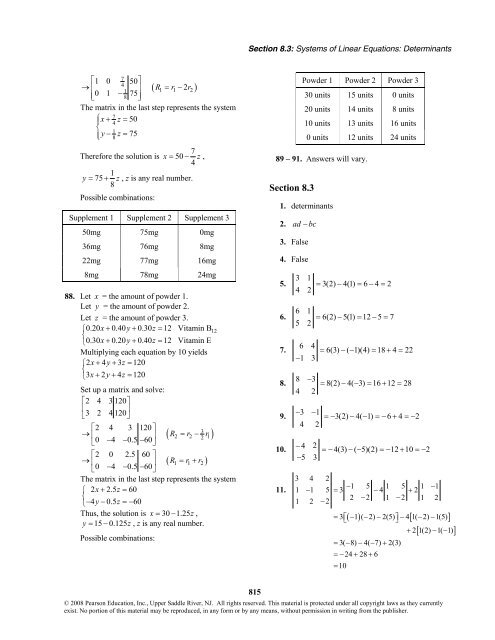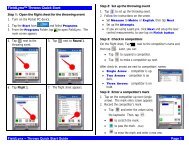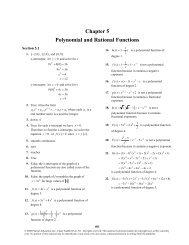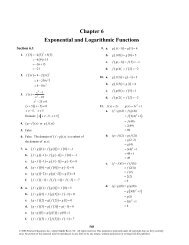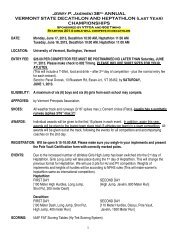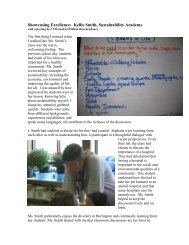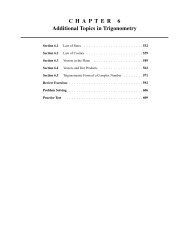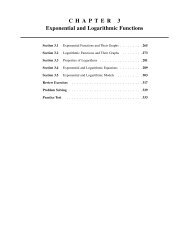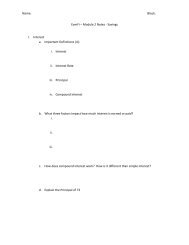Chapter 8 Systems of Equations and Inequalities
Chapter 8 Systems of Equations and Inequalities
Chapter 8 Systems of Equations and Inequalities
You also want an ePaper? Increase the reach of your titles
YUMPU automatically turns print PDFs into web optimized ePapers that Google loves.
⎡ 7 1 0 50 ⎤<br />
4<br />
→ ⎢ 1 ⎥ ( R1 = r1−2r2) ⎢⎣ 0 1 − 75 8 ⎥⎦<br />
The matrix in the last step represents the system<br />
⎧ 7<br />
⎪x+<br />
z = 50 4<br />
⎨ 1<br />
⎪⎩<br />
y− z = 75 8<br />
Therefore the solution is<br />
7<br />
x = 50 − z ,<br />
4<br />
1<br />
y = 75 + z , z is any real number.<br />
8<br />
Possible combinations:<br />
Supplement 1 Supplement 2 Supplement 3<br />
50mg 75mg 0mg<br />
36mg 76mg 8mg<br />
22mg 77mg 16mg<br />
8mg 78mg 24mg<br />
88. Let x = the amount <strong>of</strong> powder 1.<br />
Let y = the amount <strong>of</strong> powder 2.<br />
Let z = the amount <strong>of</strong> powder 3.<br />
⎧0.20x+<br />
0.40y+ 0.30z = 12 Vitamin B12<br />
⎨<br />
⎩0.30x+<br />
0.20y+ 0.40z = 12 Vitamin E<br />
Multiplying each equation by 10 yields<br />
⎧2x+<br />
4y+ 3z = 120<br />
⎨<br />
⎩3x+<br />
2y+ 4z = 120<br />
Set up a matrix <strong>and</strong> solve:<br />
⎡2 4 3120⎤<br />
⎢ ⎥<br />
⎣3 2 4120⎦<br />
⎡243120 ⎤<br />
3<br />
→ ⎢ ⎥ ( R2 = r2 − r 2 1)<br />
⎣0 −4 −0.5 −60⎦<br />
⎡2 0 2.5 60 ⎤<br />
→ ⎢ ⎥ ( R1 = r1+ r2)<br />
⎣0 −4 −0.5 −60⎦<br />
The matrix in the last step represents the system<br />
⎧ 2x+ 2.5z = 60<br />
⎨<br />
⎩−4y−<br />
0.5z =−60<br />
Thus, the solution is x = 30 − 1.25z<br />
,<br />
y = 15 − 0.125z<br />
, z is any real number.<br />
Possible combinations:<br />
Section 8.3: <strong>Systems</strong> <strong>of</strong> Linear <strong>Equations</strong>: Determinants<br />
815<br />
Powder 1 Powder 2 Powder 3<br />
30 units 15 units 0 units<br />
20 units 14 units 8 units<br />
10 units 13 units 16 units<br />
0 units 12 units 24 units<br />
89 – 91. Answers will vary.<br />
Section 8.3<br />
1. determinants<br />
2. ad − bc<br />
3. False<br />
4. False<br />
© 2008 Pearson Education, Inc., Upper Saddle River, NJ. All rights reserved. This material is protected under all copyright laws as they currently<br />
exist. No portion <strong>of</strong> this material may be reproduced, in any form or by any means, without permission in writing from the publisher.<br />
5.<br />
6.<br />
7.<br />
8.<br />
9.<br />
10.<br />
11.<br />
3 1<br />
= 3(2) − 4(1) = 6 − 4 = 2<br />
4 2<br />
6 1<br />
= 6(2) − 5(1) = 12 − 5 = 7<br />
5 2<br />
6 4<br />
= 6(3) −( − 1)(4) = 18 + 4 = 22<br />
−1<br />
3<br />
8 − 3<br />
= 8(2) −4( − 3) = 16 + 12 = 28<br />
4 2<br />
−3 − 1<br />
= −3(2) −4( − 1) =− 6 + 4 =− 2<br />
4 2<br />
− 4 2<br />
= −4(3) −( − 5)(2) =− 12 + 10 =−2<br />
−5<br />
3<br />
3 4 2<br />
1 5 1 5<br />
1 − 1 5 = 3<br />
−<br />
− 4 + 2<br />
1 −1<br />
2<br />
2 2 1 2<br />
1 2 −<br />
− − 1 2<br />
( ) [ ]<br />
+ 2[ 1(2) −1( −1)<br />
]<br />
= 3⎡⎣ −1 ( −2) −2(5) ⎤⎦−41(<br />
−2) −1(5)<br />
= 3( −8) −4( − 7) + 2(3)<br />
=− 24 + 28 + 6<br />
=<br />
10


